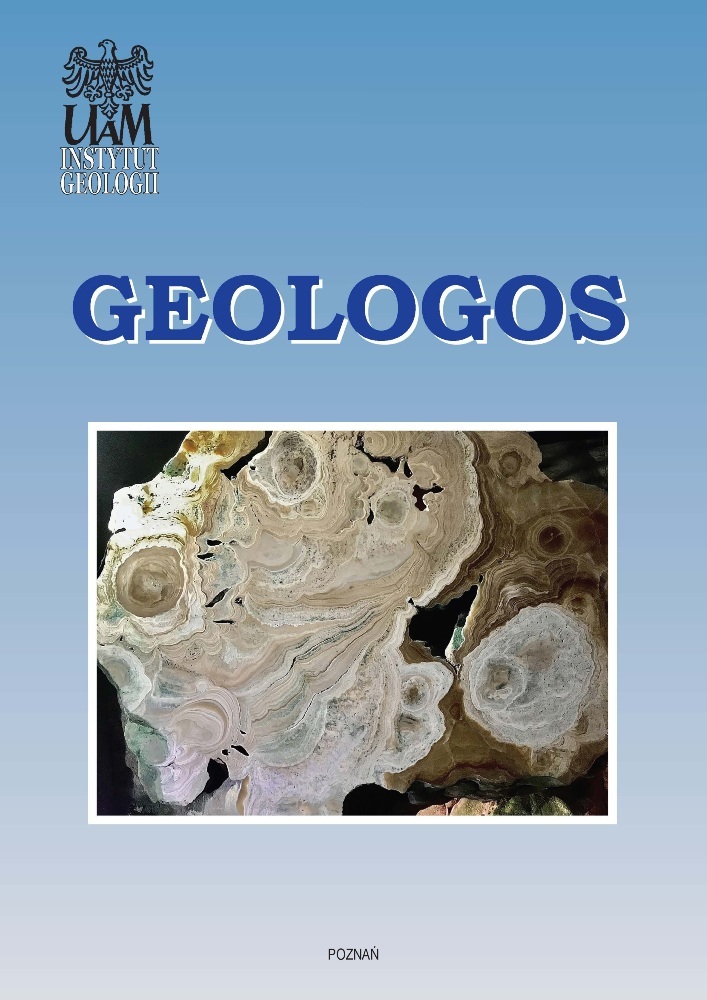Abstract
Geological mapping in combination with geophysical investigations and borehole analyses show differences of the Pleistocene between the Warmia and Mazury palaeogeographic provinces in NE Poland. The (more western) Warmia province has a crystalline basement that is covered by a folded sedimentary succession of 2–4 km thick. The (more eastern) Mazury province (eastern) has a basement that forms part of the rigid East European crystalline craton, which is covered by a sedimentary cover of only 1–1.5 km thick. Cyclic loading by the Pleistocene ice sheets in this area induced glacioisostatic processes of different intensities, resulting in changing palaeogeographic conditions. The changes were increased by intense neotectonic activity that was induced by the ice sheets in the intermediate zone between the two provinces, stretching along the western slope of the crystalline craton. Significant part of intermediate zone forms a belt of crevasse-infill landforms deposited between the Warmia and Mazury lobes of the last glaciation. Studied deposits reveal a cyclic reactivation of the interlobe zone during the successive Pleistocene glaciations. Considerable variations of the relief of the top-Neogene, vertical discontinuities cutting the Pleistocene and Neogene, stratigraphic gaps within the Pleistocene succession, and thick glaciolacustrine successions result from the vertical neotectonic movements in the intermediate area between the two provinces.
References
Ber, A., 2000. Pleistocene of north-eastern Poland and neighbouring areas against crystalline and sedimentary basement. Prace Państwowego Instytutu Geologicznego 170, 89 pp.
Ber, A., 2006. Peistocene interglacials and glaciations of northeastern Poland compared to neighbouring areas. Quaternary International, 149, 12-23.
Boulton, G. S., Dolgenmans, P., Punkari, M., Broadgate, M., 2001. Palaeoglaciology of an ice sheet through a glacial cycle: the European ice sheet through the Weichselian. Quaternary Science Revievs 20, 591-625.
Gagel, C., Müller, G., 1897. Die Entwickelung der Ostpreussischen Endmoränen in den Kreisen Ortelsburg und Neidenburg. Separatabdruck aus dem Jahrdbuch der Königl. Preuss. Geologischen Landesanstalt für 1897. Berlin.
Houmark-Nielsen, M., Kjoer, K. H., 2003. Southwest Scandinavia, 40-15 kyr BP: palaeogeography and environmental change. Journal of Quaternary Science 18, 769-786.
Kasprzak, L., Lisicki, S., 1999. Szczegółowa mapa geologiczna Polski w skali 1:50 000 arkusz Kobułty (Detailed Geological Map of Poland, 1:50,000, sheet Kobułty). Państwowy Instytut Geologiczny.
Kenig, K., 1998. Petrogaficzne podstawy stratygrafii glin morenowych Polski północno-wschodniej (Petrographic foundations of till stratigraphy of northeastern Poland). Biuletyn Państwowego Instytutu Geologicznego 380, 1-99.
Kotański, Z., 1977. Rozwój paleotektoniczny wyniesionej części starej platformy w Polsce w wałdaju i w kambrze. (Palaeotectonic development of the uplifted part of the old East European platform in Poland, during the Valdaian and the Cambrian) Biuletyn Instytutu Geologicznego 303, 15-40.
Książkiewicz, M., Oberc, J., Pożarski, W., 1974. Mapa tektoniczna Polski (Tectonic Map of Poland), Wydawnictwa Geologiczne.
Lisicki, S., 2003. Litotypy i litostratygrafia glin lodowcowych plejstocenu dorzecza Wisły (Lithotypes and lithostratigraphy of tills of the Pleistocene in the Vistula drainage basin area, Poland). Prace Państwowego Instytutu Geologicznego 177, 1-105.
Mańkowska, A., Słowański, W., 1968. Mapa Geologiczna Polski 1:200 000, arkusz Olsztyn (Geological Map of Poland, 1:200,000, sheet Olsztyn), Polish Geological Institute. Warszawa.
Mańkowska, A., Słowański, W., 1980. Objaśnienia do Mapy Geologicznej Polski 1:200 000, arkusz Olsztyn (Explanations to Geological Map of Poland, 1:200,000, sheet Olsztyn) Polish Geological Institute, Warszawa.
Morawski, W., 1984. Osady wodnomorenowe (Watermorainic sediments). Prace Instytutu Geologicznego 58, 74 pp. Warszawa.
Morawski, W., 1985. Pleistocene glacigenic sediments of the watermorainic facies. Quaternary Studies in Poland 6, 99-116.
Morawski, W., 1989. Watermorainic sediments: Origin and classification. [In:] R. P. Goldthwait, C. L. Matsch (Eds): Genetic Classification of Glacigenic Deposits 143-144. Balkema. Rotterdam/Brookfield.
Morawski, W., 2001. Szczegółowa mapa geologiczna Polski w skali 1:50 000 ark. Jeziorany (Detailed Geological Map of Poland, 1:50,000, sheet Jeziorany). Polish Geological Institute.
Morawski, W., 2003a. Objaśnienia do Szczegółowej mapy geologicznej Polski w skali 1:50 000 ark. Jeziorany (Explanations to Detailed Geological Map of Poland, 1:50,000, sheet Jeziorany). Polish Geological Institute.
Morawski, W., 2003c. Reconstruction of ice-sheet movement from the orientation of linear glacial landforms and glaciotectonic deformations near Kronowo (western Mazury, Poland). Geological Quarterly 47/4, 339-356.
Morawski, W., 2005a. Warmińska prowincja paleogeograficzna plejstocenu (południowo-wschodnia Polska) (The Warmia palaeogeographic province of the Pleistocene, north-eastern Poland). Przegląd Geologiczny 53, (6), 477-488.
Morawski, W., 2005b. Reconstruction of ice sheet movement from the orientation of glacial morpholineaments (crevasse landforms): an example from northeastern Poland. Geological Quarterly 49/4, 403-416.
Morawski, W., 2009a. Szczegółowa mapa geologiczna Polski w skali 1:50 000 ark. Biskupiec (Detailed Geological Map of Poland, 1:50,000, sheet Biskupiec). Polish Geological Institute.
Morawski, W., 2009b. Szczegółowa mapa geologiczna Polski w skali 1:50 000 ark. Dźwierzuty (Detailed Geological Map of Poland, 1:50,000, sheet Dźwierzuty). Polish Geological Institute.
Morawski, W., 2009c. Objaśnienia do Szczegółowej mapy geologicznej Polski w skali 1:50 000 ark. Dźwierzuty (Explanations to Detailed Geological Map of Poland, 1:50,000, sheet Dźwierzuty). Polish Geological Institute.
Morawski, W., 2009d. Neotectonics induced by ice-sheet advances in NE Poland. Geologos, 15, 199-217 (this issue).
Morawski, W., 2009e. A reconstruction of the Vistula ice stream during the last glaciation. Geological Quarterly 53/3
Punkari, M., 1997. Glacial and glaciofluvial deposits in the interlobate areas of the Scandinavian Ice Sheet. Quaternary Science Revievs 16, 741-753.
Roman, M., 2008. Rekonstrukcja kierunku ruchu lądolodu lobu Wisły w obszarze Pojezierza Kujawskiego i Kotliny Płockiej (Reconstruction of ice flow directions of the Vistula ice sheet lobe in the Kujawy Lakeland and the Płock Basin area). Acta Geographica Lodziensia 93, 67-85.
Słodkowska, B., 2009. Palynology of the Palaeogene and Neogene from the Warmia and Mazury areas (NE Poland). Geologos, 15, 219-234 (this issue).
Stokes, C. R, Clark, C. D., 2001. Palaeo-ice streams. Quaternary Science Reviews 20, 1437-1457.
Tyski, S., 1974. Obszar wyniesiony platformy wschodnio europejskiej. [In:] W. Pożaryski (Ed.) Budowa geologiczna Polski. Tektonika, 1. Niż Polski. Wydawnictwa Geologiczne, Warszawa.
Wysota, W., Molewski, P., Sokołowski, R. J., 2009. Record of the Vistula ice lobe advances in the Late Weichselian glacial sequence in north-central Poland. Quaternary International 30, 1-16.
License
This content is open access.
